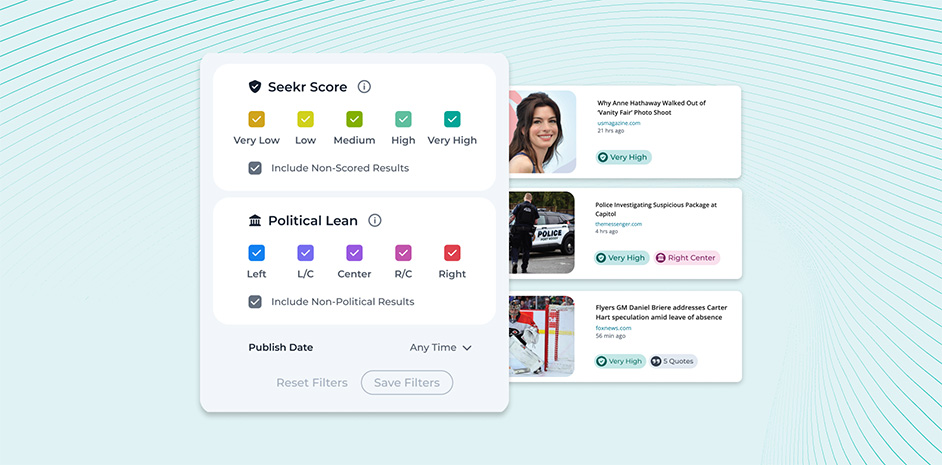With the rise of contextual programmatic advertising, the risk of brands appearing next to harmful or unsuitable content is ever-present.
That puts you in a jam.
You need to scale your advertising to reach new audiences. You also need to uphold the brand reputation you’ve built.
What if we told you there’s an effective strategy to maintain your brand’s reputation and reach your target audience in the right context?
Enter the concept of contextual brand safety.
Whether you’re struggling with maintaining your brand image online, or just looking for ways to enhance your digital marketing strategy, this post is for you.
The Importance Of Brand Safety and Suitability
Brand safety and suitability are of critical importance to brands today. You need to ensure your ads are placed in safe and suitable environments to protect your reputation and maintain consumer trust. Any association with inappropriate or harmful content can cause irreparable damage to a brand’s image.
In fact, more than 80% of consumers will SWITCH brands if their ads appear next to unsafe content.
But let’s take a step back and make sure we’re all on the same page.
Brand safety is the process of ensuring your ads don’t show up next to harmful, offensive, or inappropriate content. This can include anything from hate speech and violence to fake news and controversial topics.
Brand suitability, on the other hand, is about making sure your ads are placed in relevant and appropriate contexts that align with your brand’s values and messaging.
For example, a sports brand may want their ads to appear on websites related to fitness and healthy living, not next to articles discussing junk food and sedentary lifestyles.
Both brand safety and suitability are crucial for protecting a brand’s reputation, maintaining consumer trust, and driving successful ad campaigns.
The Rise of Contextual Brand Safety
For many years, marketers have relied on brand protection tools like keyword and website blacklists. These work to a degree, but they also have some major problems.
First, they require large amounts of human intervention to work effectively. You have to manually select the keywords you want to avoid or add websites to your blacklist, which can be a time-consuming and never-ending task.
Second, these tools often result in overblocking – meaning they block perfectly safe and suitable content that just happens to contain a “bad” word. For example, a basketball website might contain the word “shot”, which you may have blacklisted due to the possible association with violence. Even though the word is perfectly fine in context, you won’t be able to place ads there.
This brings us to the next problem…
Context.
Blacklists and whitelists don’t take context into account when evaluating whether a website is appropriate for your advertising. As such, you miss out on many valuable ad spaces that actually are safe and suitable for your brand, even though they may contain a word that’s on a blacklist.
The end result of all the above problems is that it’s very difficult to scale your advertising. It requires too much manual labor, is too restrictive, and limits the audiences you can access.
Clearly, a better solution is needed.
Enter contextual brand safety and suitability.
What do we mean by contextual brand safety and suitability?
Simply put, it’s the practice of evaluating websites and content based on their context, rather than just specific keywords or phrases. It takes into account factors like tone, sentiment, and relevance to your brand, in addition to any potentially sensitive words.
This offers a much more nuanced approach to brand safety and suitability than clunky blacklists and whitelists.
Benefits of Contextual Brand Safety and Suitability
There are a number of key benefits that contextual brand safety and suitability bring to the table.
Improved Brand Reputation and Trust
When your ads show up next to content that is inappropriate, offensive, or irrelevant, it damages your reputation and the trust you’ve built with your audience.
88% of consumers think it’s very important for advertisers to ensure that their ads don’t appear next to unsafe content.
It doesn’t matter if it was an accident. It doesn’t matter if you don’t agree with the content. When your ads show up next to harmful content, it appears as though your brand endorses that content.
On the other hand, when your ads consistently show up next to content that is both safe AND suitable, you build trust with your audience. You demonstrate that you care about the things they care about, and you position yourself as a solution to their challenges.
Increased Targeting Accuracy and Effectiveness
Contextual brand safety keeps your ads away from harmful, offensive content. Contextual brand suitability goes a step further to ensure that your ads also appear next to content that is relevant to your audience and aligned with your brand values.
This level of targeting accuracy improves the effectiveness of your ad campaigns. Ads that are placed in contextually relevant environments perform better, leading to higher click-through rates, conversions, and return on investment.
Reduced Wasted Impressions
When your ads show up in unsuitable, irrelevant locations, you’re wasting money. You’re paying for impressions that won’t result in interest or conversions. You might as well be flushing money down the toilet.
However, when your ads are targeted at contextually relevant placements, you reduce the chances of wasted impressions. You reach audiences who are more likely to engage with your brand and be interested in what you have to offer.
Enhanced User Experience
When a consumer encounters one of your ads in an unsafe or irrelevant place, it creates a jarring experience for them. It can even lead to negative associations with your brand.
Contextual brand safety and suitability help to prevent these negative experiences by ensuring that your ads are placed in appropriate, relevant environments. This enhances the user experience and positively impacts your brand perception.
Bring clarity to your campaigns
Explore IndustriesChallenges in Contextual Brand Safety
Of course, there are challenges when it comes to contextual brand safety and suitability. Some of those challenges include:
Algorithm bias
The most effective contextual brand safety and suitability tools rely on AI and machine learning to help them evaluate content at scale. However, these algorithms can be prone to bias. After all, they’re only as effective as the information they were trained on. If an algorithm was trained on biased information, it will operate according to those biases.
At Seekr, we know that the quality of the input determines the quality of the output. That’s why we’ve trained our algorithms using only the highest-quality content – content that aligns with rigorous journalistic standards.
As a result, our Seekr Score can identify biases and political lean in news and podcast content. This, in turn, allows you to ensure that your ads only appear in environments that align with your values. You can avoid sites that are biased in particular ways and place your ads next to content that is aligned with journalistic standards.
Constantly evolving content
The content on the internet is constantly changing. Additionally, your brand may change over time. Content that once aligned with your values may change to such a degree that it’s no longer aligned with your values. This poses a challenge for contextual brand safety and suitability tools, as they must adapt to these changes in order to remain effective.
Evaluating audio content
Historically, it’s been difficult for marketers to ensure brand safety and suitability in podcasts. The dynamic, free-flowing nature of these content types makes it challenging for traditional keyword-based brand safety tools to accurately determine the context.
Enter SeekrAlign™ and the Seekr Civility Score™. Seekr’s AI evaluates more than 40,000 podcasts in near real time to determine the content and context. Rooted in GARM safety standards, each episode receives a Seekr Civility Score, based on the nature of the episode and how people interacted on the episode.
This score allows you to make informed decisions regarding whether the content of a podcast matches your brand values.
Contextual Brand Safety Tools
For News Sites
News sites can be landmines for advertisers. On the one hand, you don’t want to avoid all sensitive topics. On the other hand, you don’t want your ads appearing next to content that runs contrary to your brand values.
So how do you navigate this minefield?
Seekr Score.
On the cutting edge of brand safety and suitability, it is bounded and grounded against the highest standards of journalism, natural language understanding, and 25+ advanced AI models.
Seekr Score allows you to confidently place your ads, knowing that the surrounding context will be both safe and suitable for your brand. This, in turn, enables you to scale your advertising in ways you wouldn’t be able to if you were relying on manual methods, like blacklists.
For Podcasts
Podcast listening has surged in recent years and represents a significant opportunity for advertisers to reach audiences they may not reach otherwise.
And with SeekrAlign and its Seekr Civility Score, you can ensure that your brand doesn’t get caught in a crossfire of incivility and hostility. Rather than trying to manually review podcast episodes to ensure brand safety and suitability, rely on SeekrAlign to do the heavy lifting for you.
Scale Up, Scale Safely
Contextual brand safety is an essential part of every brand’s advertising strategy, and you need a brand safety solution to ensure you are protected. With tools like SeekrAlign, you can ensure that your brand remains safe and suitable.
This is not just about protecting your brand reputation, but it’s also about opening up new opportunities, expanding reach, and scaling up your advertising efforts without compromising on safety. So, embrace the future of advertising with confidence, knowing that your brand is well-protected with contextual brand safety.
Remember, when you scale up, scale safely.




